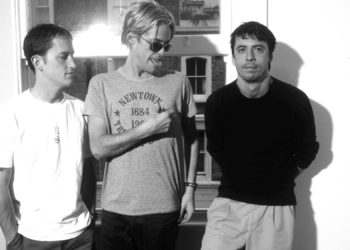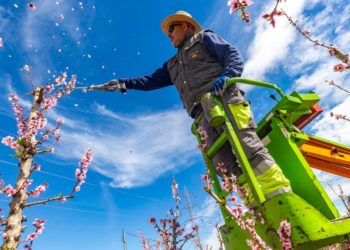Walter Robinson, a painter and journalist who reported on the New York art world in publications ranging from a freebie newspaper in the 1970s to Artnet.com, which began in the ’90s as the first digital art magazine, died on Sunday at his home in Manhattan. He was 74.
His wife, Lisa Rosen, said he died from advanced esophageal cancer that had been diagnosed last month.
As an artist, Mr. Robinson was an exuberant and unpretentious realist who culled his subjects from advertisements and other borrowed sources.
Working in acrylic paint, in a brushy style devoid of angst, he championed a “normcore” aesthetic that drolly countered a century of avant-garde innovation. His paintings depicted wide-eyed kittens, cheeseburgers on sesame-seed buns, and smiling models in polka-dot flannel pajamas from a Macy’s mail-order catalog. He favored drugstore products of the sort found in most medicine cabinets — pain killers, nasal spray, the gleaming dark blue glass of a jar of Vicks VapoRub.
Summing up Mr. Robinson’s achievements, the artist Richard Prince, a longtime friend, said, “He introduced the idea of normality as the next special effect.”
The only painting of Mr. Robinson’s known to be owned by a New York museum, “Baron Sinister” (1986), was purchased by the Whitney Museum of American Art in 2017. Rendered on a bedsheet printed with pink roses, it shows a noir scene swiped from the cover of a 1960s thriller: A secret agent — virile, square-jawed, sun-tanned — appears poised for action, his gun raised as his blond girlfriend trembles against his shoulder.
It was never clear whether Mr. Robinson thought of himself as an artist who sometimes wrote about art or a writer who sometimes painted. Rather than settling on either, he seemed to relish his identity as a double agent.
A tall, stocky man with wavy hair and an amused, slightly reticent manner, Mr. Robinson was part of that unofficial network of gallery-goers who consider it a moral obligation to keep up with art shows in New York, an ever-expanding sprawl that extends from the Upper East Side of Manhattan to the depths of Bushwick. He usually arrived at galleries on a CitiBike or, in colder weather, by public transportation.
“We were bus people,” recalled Kate Shepherd, a close friend and accomplished abstract painter who often accompanied him on his rounds.
Walter Rossiter Robinson III was born on July 18, 1950, in Wilmington, Del. The first of four children in a churchgoing Lutheran family, he was nicknamed Mike to distinguish him from his father, a civil engineer for DuPont.
When he was 4, the family moved to Tulsa, Okla., where his father had been transferred. His mother, Marguerite (Brendlinger) Robinson, was trained as psychologist and served in the women’s division of the U.S. Naval Reserve (known as the WAVES) during World World II.
In the fall of 1968, Mr. Robinson arrived in New York to study at Columbia University, where the campus was ablaze with antiwar protests. He graduated with a double major in psychology and art history in 1972.
In his senior year, he took an art criticism seminar taught by Brian O’Doherty, a charismatic Irish-born artist who was then the editor of Art in America. It was then that Mr. Robinson found his calling. Mr. O’Doherty invited him and two other students, Edit DeAk and Joshua Cohn, to write for the magazine. After graduation, the three tyro critics completed their schooling at the Whitney Museum’s yearlong Independent Study Program and, in 1973, started a zine called Art-Rite, just in time to chronicle the transformation of SoHo from a truck-and-warehouse district to the center of the international art world.
A newsprint handout, Art-Rite rejected the theory-obsessed, jargon-laden prose of academic criticism in favor of writing with a teasing warmth and informality. Mr. Robinson and Ms. DeAk distributed it themselves, dropping off copies at every gallery in SoHo. They cut their printing costs by quietly borrowing equipment from the. newspaper The Jewish Week, where Mr. Robinson worked part time as a typesetter. “I was the office goy,” he liked to joke, at least until he was fired for laying out an issue of the zine in the newspaper’s office.
Although Art-Rite was “published irregularly,” as its masthead stated unapologetically, it lasted for an impressive five years and yielded 21 issues. In 2019, the issues were gathered into a book unfussily called “Art-Rite,” a 620-page compendium that is one of the most readable accounts of the pluralistic 1970s art scene.
Trained as a writer, Mr. Robinson started his parallel career as a painter with a do-it-yourself insouciance. He did not attend art school and claimed, with his usual waggish candor, that he had acquired his technique by studying how-to-draw manuals and copying the covers of spy novels.
In 1982, he had his first solo show, at a new SoHo gallery called Metro Pictures. His gallery mates — who included the then-little-known Mr. Prince, Cindy Sherman and Louise Lawler — specialized in photo-based art and would achieve renown as the Pictures Generation. Mr. Robinson did not share their fascination with photography, and he soon shifted into the paint-around-the-clock scene unfurling in the East Village.
By the late 1980s, the art market was deluged with money from a new class of investor-collectors, and Mr. Robinson withdrew from the gallery scene. In “Quest for Failure,” an essay written in 1986 for Real Life magazine, he explained his defection with typical levity: “With success becoming so common,” he wrote, “the only way to remain unique is to fail.”
He did not mention, at least publicly, that he was dealing with a personal crisis. His second wife, Beatrice Smith, known as Bebe, the daughter of the sculptor Tony Smith, was suffering from AIDS and in need of care. She died in 1988, at 33, leaving behind a young daughter, Antonia, from a previous relationship. He adopted her and resolved to provide her with domestic stability.
“He loved Antonia,” Ms. Rosen, his fourth wife, recalled. “He used to wake up at dawn take her ice-skating before school.”
In addition to Ms. Rosen, a fine-art restorer, and his daughter, Antonia Smith-Robinson Dean, Mr. Robinson is survived by two grandchildren.
Seeking a regular paycheck, he took a series of full-time jobs: first as an editorial associate at Art in America and then, in 1996, as the founding editor of Artnet.com, the first online publication devoted to art. He stayed for 16 years, overseeing news and reviews of an ever-mushrooming museum and gallery scene, while relegating his own art to the sidelines.
He became serious about painting again in 2008, when Metro Pictures mounted a show of his work titled “’80s Paintings.” To his surprise and delight, several canvasses sold.
“I walked away with $95,000,” he later exclaimed in a video interview. “That was my half. I thought, ‘This is my retirement fund!’”
Instead, he used the proceeds to rent his first studio away from his apartment. It was in Long Island City, and he continued to work full time on his paintings there until a few weeks before his death.
In 2014, he was given his first museum survey, at Illinois State University in Normal, Ill., by Barry Blinderman, a curator who had exhibited Mr. Robinson’s paintings decades earlier at Semaphore Gallery in SoHo. The show, which was turned down by New York museums, later traveled to Deitch Projects in SoHo, where it was rapturously received. Reviewing it in The New Yorker, Peter Schjeldahl described it as a “blessed event” for a long-underrecognized artist.
“Robinson is a Manet of hot babes and a Morandi of McDonald’s French fries and Budweiser beer cans,” he wrote, in a slangy style that perhaps owed something to Mr. Robinson’s own affection for the American vernacular.
Mr. Robinson himself offered a more modest assessment of his abilities.
“I’m really into normcore,” he said in an interview with Phong Bui of The Brooklyn Rail in 2014. “I’m into being normal. Everybody else can be avant-garde. I will be normal. That way I will stand out.”
The post Walter Robinson, Exuberant Art-World Participant and Observer, Dies at 74 appeared first on New York Times.




